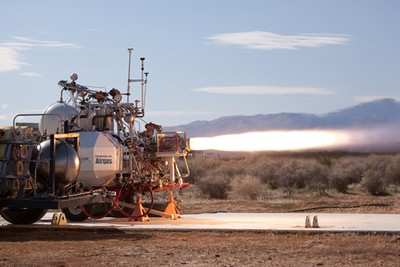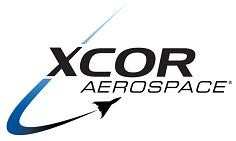Contract Signed For Liquid Hydrogen Engine Development
United Launch Alliance (ULA) and XCOR Aerospace have conductd
successful hot-fire demonstrations of a lighter-weight, lower-cost
approach to liquid-fueled rocket-engine vacuum nozzles. The new
nozzle technology, which uses aluminum alloys and innovative
manufacturing techniques, is projected to be less costly and save
hundreds of pounds of mass compared to nozzles in use today in
typical large upper-stage rocket engine systems.

Under a 2010 joint risk-reduction program by XCOR and ULA, ULA
facilitated an accelerated demonstration of the nozzle technology,
which was developed in XCOR's Lynx reusable, suborbital-vehicle
technology program. ULA sought to determine the nozzle technology's
applicability to future expendable launch vehicle programs. Earlier
in the same risk-reduction program, XCOR demonstrated the ability
to pump liquid hydrogen (LH2) using cryogenic piston-pump
technology it developed for the Lynx suborbital vehicle. Based on
the results of these successful technology demonstrations, ULA
today announced a larger follow-on program with XCOR to develop a
liquid oxygen (LOX)/LH2 engine.
Conceived as a lower-cost, risk-managed program compared to
traditional engine development efforts, the multi-year project's
main objective is to produce a flight-ready LOX/LH2 upper-stage
engine in the 25,000 to 30,000 lbf thrust class that costs
significantly less to produce and is easier to operate and
integrate than competing engine technologies. If successful, the
effort will lead to significantly lower-cost and more-capable
commercial and US government space flights delivered by ULA.

"ULA understands that we have to offer competitive prices to our
government and commercial customers along with the outstanding and
unmatched reliability they expect from us," said Dr. George Sowers,
vice president of business development and advanced programs at
ULA. "By working with XCOR, we see the potential to develop engines
that offer the performance and reliability our customers need at a
more affordable price."
The companies structured their LOX/LH2 engine development
program with multiple "go / no-go" decision points and performance
milestones to ensure a cost-effective and risk-managed approach to
this challenging effort. As demonstrated during prior ULA and XCOR
joint engagements, XCOR's small-company environment facilitates
rapid turnaround for build and test cycles that drive innovative
learning, while ULA's small company project management approach
ensures their needs are met but does not stifle the creative
process or saddle XCOR with excessive paperwork burdens typical of
large government contracts. In addition, ULA is helping to bolster
the Tier 2 and Tier 3 aerospace-industrial supply chain in the
United States, which is critical to ensuring the United States
aerospace sector remains competitive in the global marketplace.
"This announcement validates XCOR's business mantra of 'stay
focused on propulsion, Lynx and the customer' and ULA is a great
customer," said Andrew Nelson, Chief Operating Officer at XCOR.
"And when you have innovative, safe, low-cost and fully reusable
technologies that fly multiple times a day, those technologies will
find other buyers, such as ULA. Whether it is non-toxic thrusters,
fully reusable main-engine propulsion, cryogenic flight-weight
piston pumps, or non-flammable cryogenically compatible composite
tanks and structures – the future looks bright for XCOR."
The demonstrations announced Monday are from integrated
engine/nozzle test firings with XCOR's Lynx 5K18 LOX/kerosene
engine. The engine/nozzle combination demonstrates the ability of
the aluminum nozzle to withstand the high temperatures of
rocket-engine exhaust over numerous tests, with no discernable
degradation of the material properties of the alloys. The
tests validated the design, materials and manufacturing processes
used in the nozzle, and laid a foundation for scaling the design to
EELV-sized engines. The results also demonstrate the reusability of
the engine and nozzle combination which is essential for low-cost,
daily suborbital flights by the Lynx and other vehicles.

"We are honored to work with the great team of individuals at
ULA, a Tier 1 aerospace supplier," said Jeff Greason, XCOR CEO.
"The critical engine technology we're developing for ULA may one
day launch satellites, capsules and space stations for government
and commercial customers. Customers such as the US Air Force, NASA,
the National Reconnaissance Office, Boeing and Bigelow Aerospace
all stand to benefit from this partnership. For a rocket engineer,
there is nothing more exciting than firing a new engine for the
first time. We can't wait for the day when we first fire the new
hydrogen engine for ULA."
 ANN's Daily Aero-Term (04.20.24): Light Gun
ANN's Daily Aero-Term (04.20.24): Light Gun Aero-News: Quote of the Day (04.20.24)
Aero-News: Quote of the Day (04.20.24) ANN's Daily Aero-Linx (04.21.24)
ANN's Daily Aero-Linx (04.21.24) Aero-News: Quote of the Day (04.21.24)
Aero-News: Quote of the Day (04.21.24) ANN's Daily Aero-Term (04.21.24): Aircraft Conflict
ANN's Daily Aero-Term (04.21.24): Aircraft Conflict





